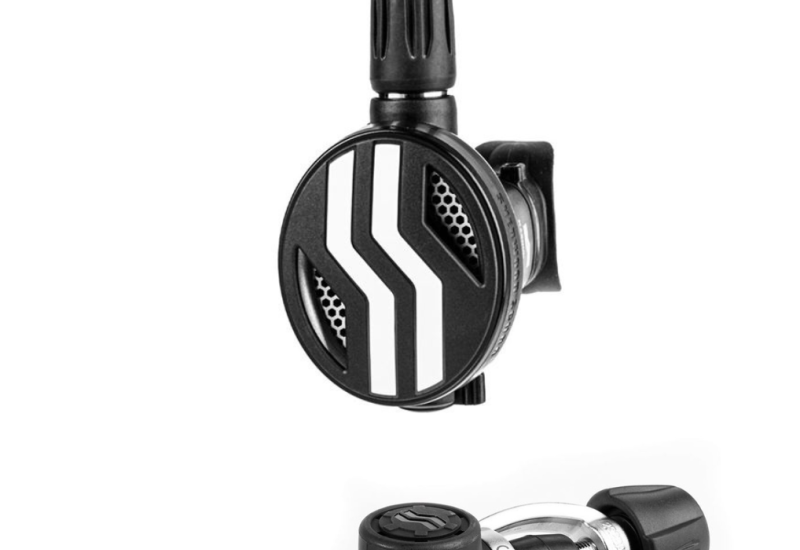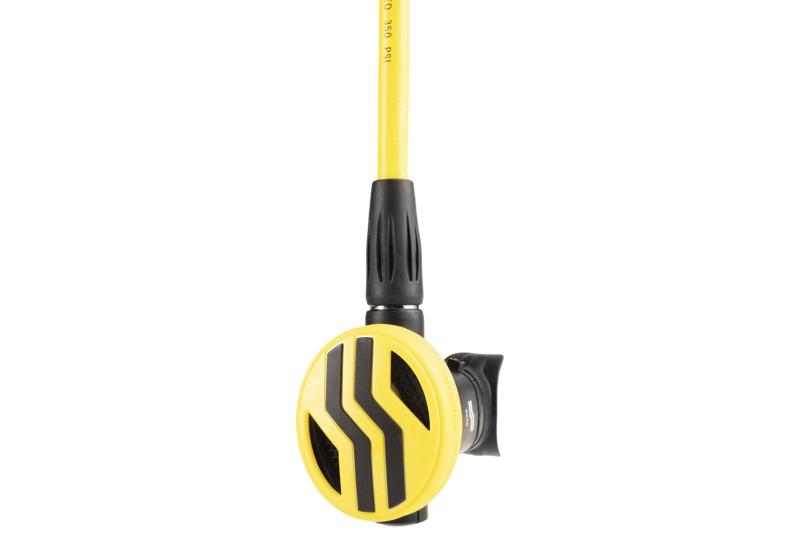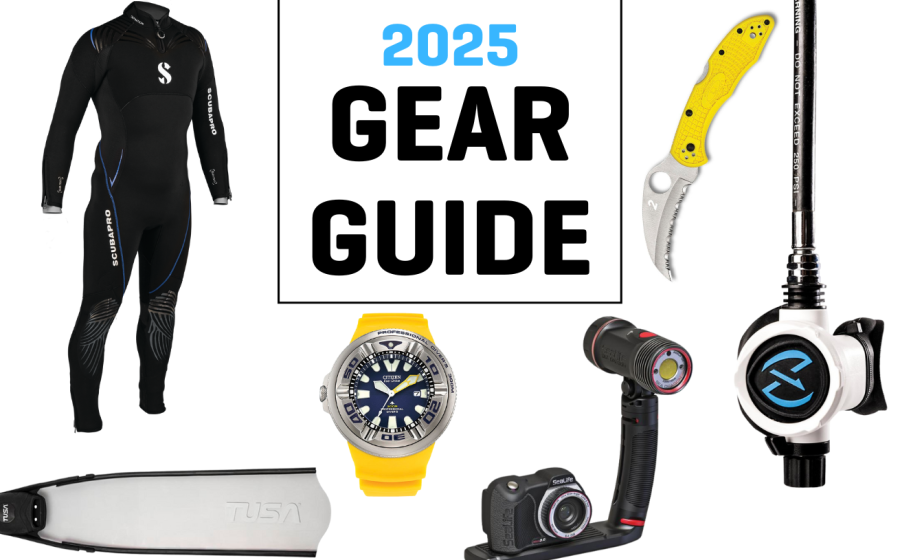Best New Regs Of 2006

By John Brumm
Photography by Joseph Byrd
| Best New Regs Of 2006 Chart--(1.1MB PDF) |
Need an excuse to buy a new regulator? Our annual review of the latest models to hit dive stores will give you 18 state-of-the-art reasons to upgrade your most important piece of gear.
Never in the 14-year history of Scuba Lab have we encountered a group of regulators able to perform so well on the breathing simulator, while also delivering such dependable service to our test divers in real-world diving conditions. Of the 18 new or redesigned models in this year's review, 14 earned our highest rating (Testers' Choice), and no regulator in our review earned an overall rating lower than Very Good. This remarkable feat is all the more impressive when you consider that this class of regulators runs the gamut of features, prices and styles.
Putting Them to the Test
Our annual review of new regulators reports the results of Scuba Lab's most comprehensive evaluation process (for more details see "How and Why We Test Regulators," pg. 89). In Phase 1 we collected regulators, inspected them and pored over owner's manuals, taking copious notes on features and performance promises.
In Phase 2, we took the regs and a team of eight experienced test divers (plus two data collection supervisors) to Catalina Island, Calif., for three days of test diving in an ocean environment. Each test diver dived each reg, rating its performance in seven specific ergonomic categories using a one-to-five scale. Test divers also provided written comments on each reg.
In Phase 3, we put each reg on an ANSTI breathing simulator at an independent test facility. The ANSTI machine allows us to precisely measure the breathing resistance of each reg at a variety of breathing rates and depths. Our standard panel of breathing machine tests range from normal breathing at recreational dive depths to high-demand situations at extreme depths. In total, we gathered more than 720 data points, along with more than 100 pages of breathing loops (a graphic representation of a regulator's total inhalation and exhalation performance). This data was translated into numeric scores and combined with ergonomic test results and test diver comments to come up with the year's top breathers.
The reviews that follow have been divided into two groupsÑOver $500 and Under $500Ñand are summaries of our findings. For complete test results, see the chart on p. 90.
Testers' Choices
The top performers in this price range all delivered excellent performance on the breathing simulator and scored above average in virtually all ergonomic categories.
Regulators Over $500
ATOMIC AQUATICS: B2, Z2 and M1

SCUBA DIVING Testers' Choice
>>SIMULATOR SCORES: 25 out of a possible 25.
>>ERGO SCORES: 58 out of a possible 70.
This year Atomic Aquatics submitted three regs for review: one new model and two upgrades. The Z2 is the newbie; it was released late last year. The B2 and M1 have been around for awhile, but Atomic has redesigned their second-stage cases and added new Automatic Flow Control (AFC) flow vanes to improve overall breathing performance.
All three of these models share the same basic first stage, a compact, balanced flow-through piston design with five low-pressure ports on a turret for easy hose routing. The second stages are pretty much the same too. They all offer AFC, which automatically adjusts airflow to maintain a stable breathing effort regardless of depth, and they feature Atomic's Seat Saving Orifice, which helps prolong second-stage seat life.
What sets these regs apart is primarily metals, plating and user-specific features. For example, the B2 couples a first stage made of polished 316 stainless steel and brass, to an all-titanium second-stage valve body for a lightweight reg with superior corrosion resistance. The second-stage hose also comes standard with Atomic's excellent Comfort Swivel (available as an option on the M1 and Z2). The Z2 we tested came with the same low-pressure port turret as the B2, but it actually comes standard with a fixed seven-port first stage that is more than $100 cheaper than the test rig. (The Z2 price listed in the features chart includes the turret option.) Its brass second-stage valve body is plated with palladium/zirconium for corrosion resistance, and the lever, orifice and second-stage spring are titanium.
The M1 is designed with technical divers in mind. Its first stage is made of brass and Monel, a high-grade alloy known for its strength, corrosion resistance and oxygen compatibility. The first stage comes standard with an environmental kit for cold-water diving (optional on other Atomic regs). Its second-stage valve body is made with palladium/zirconium plated brass with titanium components, and it's fitted with a thermal heat sink. The reg comes from the factory nitrox-ready to 50 percent, and oxygen mixes up to 80 percent can be used when special guidelines are followed. The reg has a slightly wider exhaust tee than other Atomic regs and its purge cover has flow slots cut into the sides to reduce free-flows when swimming into currents.
True to Atomic's claims, the redesigned B2 and M1 did deliver improved work of breathing on the simulator, although this improvement simply puts a shine on what was already stellar breathing performance. The Z2 effortlessly kept pace with its higher-priced brethren. When the regs were taken out for some real-world diving they proved to be sweet breathers in all positions. Test divers considered the B2, Z2 and M1 to be the driest breathing regs in this year's go-round. The regs come with a two-year/300-dive service interval, and the limited lifetime warranty is not contingent upon annual servicing.
APEKS: XTX200, XTX100 and XTX50

SCUBA DIVING Testers' Choice
>>SIMULATOR SCORES: 25 out of a possible 25.
>>ERGO SCORES: 55 out of a possible 70.
First Apeks gave us its TX Series of regs. Then came the ATX Series with smaller second stages. Now Apeks offers its XTX Series, so-named for their ability to convert the second stages to either left-hand or right-hand hose configuration (this switch must be performed by an authorized Apeks technician). The XTX200, XTX100 and XTX50 make up the top level of the XTX Series. Their pneumatically balanced second stages are virtually identical (the XTX50 doesn't have a chrome accent ring, but that's about it). They use the same efficient ratcheting Reversible Venturi System (RVS) dive/pre-dive switch, as well as a breathing-resistance knob that's notched so it's easy to use when wearing gloves. The regs also come with a choice of two easy-to-switch exhaust tees. We used the wider tee for all our tests, which kept bubble interference to a minimum. The narrower tee is lighter and more compact, but not quite as efficient in bubble dispersion.
While these regs sport different first stages, all are over-balanced diaphragm designs complete with dry seal environmental kits. This over-balancing feature allows the intermediate pressure in the second-stage hose to increase at a rate faster than ambient pressure, resulting in more responsive inhalation. The XTX200, flagship of the XTX Series, uses an elegant-looking first stage similar to the one found on the limited edition Black Pearl a couple years ago, but this version has a polished chrome finish. The satin-finished XTX100 first stage orients its external diaphragm downward, and the whole rig has a bullet-proof look. The XTX50 first stage incorporates four low-pressure ports on a rotating turret for optimal hose routing.\
When strapped to the breathing simulator, these three regs aced every RMV/depth category without breaking a sweat. They then repeated this performance in the ocean, where test divers rated them above-average breathers in all positions and very user-friendly when purging and operating the second-stage adjustments. All three regs come with a free parts replacement program.
AQUA LUNG: LEGEND SUPREME ACD, LEGEND LX ACD and LEGEND LX SUPREME ACD

SCUBA DIVING Testers' Choice
>>SIMULATOR SCORES: 25 out of a possible 25.
>>ERGO SCORES: 55 out of a possible 70.
Aqua Lung's top-end line of Legend regulators comes with a new feature designed to extend the life of the first stage. Called the Auto Closure Device (ACD), this seal closes off the first-stage inlet as soon as the reg is disconnected from the cylinder valve. This keeps water from entering the first stage during tank changes and post-dive rinses.
The Legend series uses an over-balanced diaphragm first stage with a dry seal environmental kit. The over-balance feature allows the intermediate pressure in the hose to increase at a rate faster than ambient pressure, resulting in more responsive inhalation. The black polyurethane coating gives the first stage a stylish Euro look while protecting the metal surfaces. Two high-pressure ports and four low-pressure ports are angled for optimum hose routing. Polished chrome port plugs that are flanged and dimpled further enhance the look.
The second stages on these three models, as well as on the standard Legend (see Under $500 regs, p. 57) are pneumatically balanced and come with easy-to-use Vane Adjustment Switches (VAS). The LX versions add a breathing-resistance knob so you can dial in or out on your inhalation effort at depth. The Legend LX comes with a gold accent ring on its second stage to differentiate it from the Legend Supreme and Supreme LX, which are Aqua Lung's cold-water models (recommended for water temperatures below 50 degrees). They come with a polished chrome yoke end cap on the first stage and a chrome retaining ring and laser-etched snowflake on the second stage. All Legends offer a choice of a Comfo-Bite or a standard mouthpiece, along with a reusable mouthpiece clamp for switching back and forth. The Legend Supreme and Supreme LX also include a rubber shield that fits over the mouthpiece to keep lips warm.
The snazzy design of these regs might suggest they're all style and no substance. But don't be fooled by good looks. These regs are some powerful breathers. On the breathing simulator, each model delivered surprisingly low work of breathing, regardless of how deep we took them or how high we cranked up the breathing rate. In the water, divers found these regs to be sweet breathers, dry, with powerful purges and simple user adjustments. The cold-water lip shield on the Supreme and Supreme LX took a bit of getting used to, but everybody agreed it helped keep lips warm. All three regs are available with a free parts replacement program.
Regulators Under $500
SCUBAPRO: MK17/S555

SCUBA DIVING Testers' Choice
>>SIMULATOR SCORES: 25 out of a possible 25.
>>ERGO SCORES: 54 out of a possible 70.
The new MK17 balanced diaphragm first stage is known around Scubapro as "The Icebreaker" because it has been designed for harsh environments and cold water use. Its Thermal Insulating System (TIS) and Anti Freeze (AF) System both protect internal parts with ice-repellent coatings and accelerate heat transfer, and a dry ambient chamber system prevents water intrusion for trouble-free operation in the coldest of water conditions.
The pneumatically balanced S555 second stage is also new. Its housing is made of metal and techno-polymer with carbon fiber to insulate and protect the valve-lever assembly. While the second stage has no breathing resistance knob, the Venturi Initiated Vacuum Assist (VIVA) is efficient in controlling surface free-flows, although the switch is small and can be hard to grasp when wearing gloves. But the purge is large and forceful, and the reg is a dry, easy breather in all positions. It comes with an orthodontically designed mouthpiece, making it one of only three regs to earn a clear majority of positive votes when rated for comfort. On the breathing simulator, the MK17/S555 was able to keep up with the best of them, earning the highest possible scores in all RMV/depth categories.
APEKS: TUNGSTEN ATX

SCUBA DIVING Testers' Choice
>>SIMULATOR SCORES: 25 out of a possible 25.
>>ERGO SCORES: 53 out of a possible 70.
The Apeks Tungsten ATX gets its name from its rugged tungsten-steel color. It's similar to the ATX200, but has a durable PVD (physical vapor deposition) coating to protect the metal of the over-balanced first stage. This over-balanced feature actually increases inter-stage pressure at a rate faster than on traditional balanced models to help compensate for denser air. The first stage also has a dry environmental sealing system that eliminates the need for silicone, oil or grease.
The second stage is pneumatically balanced with a specially designed cover plate that surrounds an efficient center purge button. Its Integrated Venturi System (IVS) isn't ratcheted like on the XTX Series' RVS switches mentioned above, but it's just as effective. The reg also comes with a breathing resistance knob that's slotted to make it easy to grip when wearing gloves.
The Tungsten ATX was able to keep pace with its XTX Series cousins on the breathing simulator and in almost all real-world ergonomic tests. However, the reg uses a narrower exhaust tee. This makes for a compact second stage but allows for a bit more bubble interference. The Tungsten ATX comes with a free parts replacement program.
MARES: V42 PROTON METAL and V32 PROTON ICE EXTREME

>>SIMULATOR SCORES: 23 out of a possible 25.
>>ERGO SCORES: 50 out of a possible 70.
Mares calls the V42 the smallest balanced diaphragm first stage on the market, and we believe it. The tiny V42 has a forged brass, nickel and chrome-plated body. The high-pressure valve features the Spherical Core Seal (SCS) to increase system durability. The low- and high-pressure ports are angled so hoses can be comfortably routed. The Dynamic Flow Control (DFC) on the primary low-pressure port minimizes the intermediate pressure drop which occurs during inhalation.
While the V42 can be fitted with a cold-water kit for harsh conditions, the V32 first stage comes standard with a cold-water kit that isolates all its internal components from contact with the water. Like the V42, it also has DFC and angled pressure ports for hose routing.
Both regs use compact, all-metal second stages made of nickel and chrome-plated brass. The Proton Ice Extreme is also coated with nonstick fluoropolymer resin to prevent ice crystals from sticking to the metal. This helps make it such a good cold-water performer that it survived testing by the U.S. Navy in saltwater chilled to 29 degrees Fahrenheit. A new version of Mares' Vortex Assisted Design (VAD) incorporates a bypass tube into the body of both second stages. As the air from the hose passes through the second-stage valve, it is routed directly to the mouthpiece via the tube. This contributes to a lower breathing effort at depth. The oversized purge button on both second stages is extremely easy to use, even while wearing gloves, and the mesh grids minimize free-flows in currents.
On the breathing machine, both regs delivered very good to excellent scores. In real-world diving conditions, test divers loved the lightweight, compact size of the V32 Proton Ice Extreme and the V42 Proton Metal. The second stages eschew diver adjustments, keeping things simple. They also breathe easy in a normal swimming position, although our V32 Proton Ice Extreme had a tendency to whistle when subjected to deep inhalations at depth. Their narrow exhaust tees allowed a bit more bubble interference than some of the other regs tested, but not so much that it was considered a problem.
AQUA LUNG: LEGEND ACD

SCUBA DIVING Testers' Choice
>>SIMULATOR SCORES: 25 out of a possible 25.
>>ERGO SCORES: 55 out of a possible 70.
The Legend ACD is the standard model of the Legend line, and the only one to retail for less than $500. Yet when it comes to breathing performance, it can stand up to any of the more expensive Legends (see Over $500 regs). It also uses the Legend Series' black over-balanced diaphragm first stage with dry seal environmental kit, and features Aqua Lung's new Auto Closure Device (ACD) to keep water and contaminants out of its first stage. The second stage is fitted with a Vane Adjustment Switch (VAS) and dressed up with a gold accent ring. Basically, the only thing different between this Legend and the Legend LX is the lack of a breathing resistance knob, which allows you to dial in or out on your inhalation effort at depth. Performance-wise, they are virtually identical.
APEKS: XTX40 and XTX20
SCUBA DIVING Testers' Choice

>>SIMULATOR SCORES: 25 out of a possible 25.
>>ERGO SCORES: 53 out of a possible 70.
The XTX40 and XTX20 are the lower-priced models in Apeks' new XTX Series. Their second-stage valves are also reversible, allowing the hose to be configured on the right or left side, and they offer the ability to switch between two styles of exhaust tees. Both regs use a pneumatically balanced second stage with a nonratcheting Reversible Venturi System (RVS) switch, but no breathing-resistance knob. They are also fitted with Comfo-Bite mouthpieces. The XTX40 uses the same over-balanced diaphragm first stage with dry seal environmental kit and low-pressure port turret as the XTX50. The XTX20, the lowest-priced model in the XTX line, uses a very compact, balanced diaphragm first stage and is referred to as the XTX Series' warm-water model (designed for water temperatures above 50 degrees Fahrenheit).
Performance-wise, these two regs are nearly identical to the higher-end XTXs, both on the breathing simulator and in real-world diving. In fact, the only category where they earned a slightly different score was in bubble interference, and that's because they were fitted with the narrower of the two available exhaust tees. (Both of these regs come standard with the narrow exhaust tee, though the wider tee is available as an option.) Otherwise, they were identical in performance to the top-end XTX regs. They also come with a free parts-replacement program.
ZEAGLE: REZORT (SCUBA DIVING Best Buy) and RAZOR

>>SIMULATOR SCORES: 22 out of a possible 25.
>>ERGO SCORES: 53 out of a possible 70.
These two new inexpensive regs deliver a lot of breathing performance for not a lot of money. They both use unbalanced flow-by piston first stages and rock-solid pneumatically balanced second stages with efficient dive/pre-dive switches. But while the ReZort's first stage is a traditional yoke style, the RaZor first stage assembly screws directly into a standard 3,000 psi cylinder. It includes a safety relief valve and an on/off knob to create a very simple, low-profile set-up that's perfect for stage bottles or for redundant air supply systems. It comes with a filling adapter so you can refill the tank using a standard whip.
Both regs deliver excellent performance at depths and breathing rates simulating typical recreational diving, and very good performance at more aggressive breathing rates and greater depths. In the water, both systems breathe well in the swimming position, but not as easily upside down, where they also tend to get some moisture. Wide exhaust tees minimize bubble interference. The dive/pre-dive switch is easy to use and the purge button, while a bit stiff, can really move some air. They are two of only three regs that received a clear majority of positive votes from test divers for their mouthpieces. While the RaZor is more of a special-use rig, the standard yoke ReZort, with its above-average performance and rock-bottom price, definitely gets our vote for a Best Buy.
More Testers' Choices
Still looking for the perfect reg? Here are the top performers and their test scores from last year's reg review. They're still in distribution, and definitely worth a look.
Over $500 Atomic: T2
>>Simulator Score: 25 out of a possible 25.
>>Ergo Score: 68 out of a possible 70.
The Ferrari of regulators with a price to match. Both the first and second stages are made from solid billet titanium components. The reg manhandled the breathing machine and earned the highest ergonomic scores of any regulator we've tested in the past five years. Price: $1,395.
Under $500 Oceanic Delta: 4/FDX-10
>>Simulator Score: 23 out of a possible 25.
>>Ergo Score: 58 out of a possible 70.
This reg comes loaded with goodies, including Dry Valve Technology (DVT) to keep water out of the first stage and Oceanic's patented Dynamic Adjustment on the second stage. This balancing system maintains a constant opening effort throughout the dive. Dial in your sweet spot, then leave it alone. The reg will automatically adjust to changes in depth. Price: $499.95.
Under $500 Mares: Abyss 05
>>Simulator Score: 22 out of a possible 25.
>>Ergo Score: 57 out of a possible 70.
Thanks to an all-metal second stage and a beefy MR22 balanced diaphragm first stage, you get a bulletproof reg that breathes effortlessly without user adjustments. It also combats dry mouth. Test divers praised it for quiet and dry breathing in all positions. Price: $499.
Under $500 XS: Scuba SeaAir Tri-Metal
>>Simulator score: 22 out of a possible 25.
>>Ergo score: 56 out of a possible 70.
Who says you have to spend a fortune to get raw power? This budget reg can hang with any top-dollar model when it comes to raw breathing performance in recreational conditions and when pushed to extremes. Price: $375.
Under $500 TUSA: RS-460 X-Pert
>>Simulator score: 22 out of a possible 25.
>>Ergo score: 54 out of a possible 70.
This simple and efficient breather combines a compact balanced diaphragm first stage with a lightweight second stage. Test divers found it a very easy breather in all positions. Price: $320.
Regulator Features to Consider
>> Piston or diaphragm first stage. To admit air from the tank into the regulator, first stages use a piston sliding in a smooth cylinder or a diaphragm (like a loose drumhead) that flexes. Each has advantages and disadvantages, but both can offer excellent breathing performance.
>> Balanced or unbalanced first stage. Balancing is an attempt to keep air delivery stable when tank pressures are low or demand on the regulator is high. However, many unbalanced first stages offer breathing performance very similar to balanced ones.
>> Number of ports. More ports means better hose routing options.
>> Balanced or unbalanced second stages. Balanced second stages can make the air flow more consistent, but most modern unbalanced second stages do just as well in the ergo and simulator tests.
>> Dive/Pre-dive switch. A second-stage adjustment useful to prevent free-flows on the surface.
>> Breathing resistance knob. Designed to be used under water, it can be used to tune out positive pressure breathing and free-flows caused by current.
>> Nitrox capability. Not all regs come factory-ready for oxygen enriched breathing gases.
>> Environmental sealing. Environmentally sealed first stages keep water out of the workings to prevent icing in cold (below 50F) or contamination in dirty water.
How (And Why) We Test Regulators
Scuba Lab is the only consumer products testing organization that works for the sole benefit of recreational divers. The goal of our exclusive Scuba Lab Reviews (found only in Scuba Diving magazine and archived on www.scubadiving.com) is to help you be an informed consumer of dive gear.
To fulfill this mission when testing regulators, we use an industry-standard ANSTI wet breathing machine, which is capable of measuring minute differences in the inhalation and exhalation resistance at variety of depths and breathing rates. Following internationally accepted test standards, a regulator's work of breathing (WOB) is measured in joules per liter for each complete inhale/exhale cycle, during which the highest inhale or exhalation pressure experienced by the "diver" should never exceed 25 millibars or a total WOB of 3 j/l.
If a reg exceeds either parameter, it "fails" our test, but that doesn't mean that it stops delivering air-only that the breathing resistance at some point in the cycle is higher than what is common for most modern regulators. All simulator tests are performed at a supply pressure of 725-760 psi. If a regulator can perform well at this supply pressure, it will perform as well or better at higher supply pressures.
Breathing Rates and Depths
Regulators are tested at four different RMV/depth combinations (RMV stands for Respiratory Minute Volumes-basically the amount of gas that is ventilated through the lungs in one minute). Here are the tests and what they represent:
>Column A: 37.5 RMV @ 132 fsw. A somewhat aggressive breathing rate at the maximum recreational diving depth. A physically fit recreational diver might breathe at this rate while swimming a long distance. (A relaxed diver on a drift dive will probably be breathing at 22 RMV or less.) A diver could theoretically maintain 37.5 RMV for five minutes or longer without becoming significantly winded.
>Column B: 75 RMV @ 132 fsw. An extremely aggressive breathing rate at the maximum recreational diving depth. A diver in excellent condition can breathe at 75 RMV for about one minute. This test represents how a reg might perform with a single diver breathing at an extremely heavy work rate. It also serves as a loose simulation of the stress a reg would be under if two divers were breathing off the same first stage in an air-sharing situation. Only the U.S. Navy and Scuba Lab use this breathing rate to help identify the outer limits of a reg's performance.
>Column C: 62.5 RMV @ 165 fsw. All regs sold in the European Common Market must pass a test standard known as EN250, which uses this RMV/depth as its benchmark. For this reason, it's also the depth and breathing rate most commonly used by manufacturers to test regulators. This is a very aggressive breathing rate. A recreational diver in excellent condition chasing a bat ray through open water would probably be able to maintain 62.5 RMV for only a few minutes.
>Column D: 62.5 RMV @ 198 fsw. This is the U.S. Navy's Class A test depth and breathing rate, although they use a higher supply pressure than our standard 725-760 psi. We conduct this extreme test (no diver should ever be breathing this aggressively at this great a depth with this little air in left in his tank) to explore the outer limits of a reg's performance.
Scoring the Results
A machine as accurate as the ANSTI simulator can accurately differentiate j/l measurements to tenths and even hundredths of a point. Human divers, however, can't detect differences much smaller than about .5 j/l. So for the sake of simplicity, we translate j/l measurements into scores on a 2 to 5 scale as follows:
5 = Excellent: A total WOB of 1.05 j/l or less.
4 = Very Good: A total WOB of 1.06 to 1.55 j/l.
3 = Good: A total WOB from 1.56 to 2.25 j/l.
2 = Fair: A total WOB of 2.26 to 3.0 j/l.
If a reg is unable to achieve the RMV/Depth category, its maximum depth within test parameters is recorded instead of a score.
Ergonomic Tests: The Human Factor
Breathing machines tell only half the story, however. To gauge the ergonomic traits of regulators, we use a minimum of six test divers. These divers represent a cross section of the sport and differ in age, dive experience, gender and diving interests. Each diver rates each reg for user friendliness in seven areas, divided into three categories:
Most Important
>Ease of breathing: How well a regulator delivers air in the standard swimming position.
>Different positions: How the regulator breathes when the diver is in a heads-up or face-down position.
>Dryness: Does the regulator breathe wet or dry in both a normal swimming position and odd swimming positions.
Moderately Important
>Bubble interference: Considered while looking down, straight ahead, up at a 45-degree angle and straight up.
>Ease of clearing: Divided into two parts: 1) How easy is it to find and use the purge button, and the force of the purge. 2) How much effort is required to clear the regulator using the blowing method.
Convenience Items
>Comfort: Test divers rate the comfort of the mouthpiece, the feel of the second stage in the mouth, hose lengths and stiffness.
>Adjustments: Are adjustments easy to find, grip and turn? Do they do their job in a reasonable manner? Performance is recorded using both numeric scores on a 1 to 5 scale (5=Excellent, 4=Very Good, 3=Good, 2=Fair, 1=Poor) and written comments.
How We Pick Testers' Choice
In this review, Scuba Lab ratings-including Testers' Choice-are awarded within price ranges based on total scores for simulator and ergonomic tests.
Ergonomic scores are adjusted as follows: Actual scores x 3 for "Most Important" categories, actual scores x 2 for "Moderately Important" categories, and actual scores x 1 for "Convenience Elements" excluding user adjustments, which aren't found on every reg.
Simulator scores are adjusted x 2 only for Column A, the RMV/Depth test that best represents typical recreational diving (37.5 RMV @ 132 fsw).
User Adjustments Explained
Not all manufacturers offer user adjustments on their regs, because not all divers want to hassle with knobs and switches while they're enjoying the sights under water. But for those divers who like to take a hands-on approach to air delivery there are basically two types of user adjustments:
>> Breathing-resistance knobs
These controls enable you to adjust your breathing effort based on diving conditions like depth or current. As you dial in on the knob, pressure is put on the second-stage spring, which pushes on the seat, which increases breathing effort. This can be a good thing when passing through a surf line or swimming into a strong current. Dial out on the knob and spring and seat pressure are eased, making it easier to generate airflow. This can reduce breathing effort when descending to greater depths.
>> Dive/Pre-Dive Switches
Often known by such proprietary names as Vane Adjustment Switch (Aqua Lung), Integrated Venturi System and Reversible Venturi System (Apeks) and Venturi Initiated Vacuum Assist (Scubapro), these controls change the angle of a vane inside the second stage casing. When turned to the "closed" or "minus" position, the vane adjusts to deflect airflow inside the casing, reducing a reg's sensitivity to free-flow while on the surface. Once you get under water, turn the switch to the "open" or "plus" position, the vane rotates and you have maximum airflow with which to enjoy your dive.
Regulator Warranties
Regulator manufacturers appear to be heading in the same direction-which is a good direction for divers-when it comes to warranties. In 2003, of the 24 regs submitted for testing, only 13 offered limited lifetime warranties. In 2004 nine regs out of a total of 15 offered limited lifetime warranties, and in 2005 it was six out of 12. But this year, of the 18 regs submitted by manufacturers for review, every single one of them come with a limited lifetime warranty. Whether this is a result of market pressure, or the simple fact that these regs are so much better than your average breathers, the real winners are today's divers.
Mystery of the Mouthpieces
We don't know if it's because these regs performed so well that test divers had time to obsess on minor matters, or if the 58-degree water temperatures during our test dives caused them to be more sensitive than usual, or if a larger percentage of female divers this year skewed score averages. But this time around, when it came to comfort scores, we couldn't get a clear consensus-good or bad-on the majority of this year's mouthpieces.
In past years' tests, Atomic's dual silicone mouthpiece was rated an across-the-board favorite. But this year, while most male test divers found the dual silicone mouthpiece to their liking, most female test divers felt it was a bit too big. The same was true with Aqua Lung's Comfo-Bite mouthpiece, as well as the mouthpiece on both Mares' regs. In each case, there was no middle-of-the-road position; divers either really liked the mouthpiece, or they really didn't like it. (Scubapro and Zeagle mouthpieces were the only exceptions to this.)
Consequently, while the regs in question averaged a Good rating for comfort (see Ergonomic Performance chart, p. 91), this doesn't reflect the opinion that these mouthpieces were only average. Rather, it's the midpoint between extreme opinions. Bottom line: While the mouthpiece is arguably the most personal part of a regulator, it's also the easiest thing to change if you don't happen to like it.
MANY THANKS To Mike Ward of Dive Lab, Panama City Beach, Fla., for his work on the ANSTI breathing simulator; to George Perez of Sea Divers, Enterprise, Ala., for his technical support during lab tests; and to Express Divers, Long Beach, Calif., for the in-water portion of the tests aboard Island Time.

By John Brumm
Photography by Joseph Byrd
|| |---|
| Best New Regs Of 2006 Chart--(1.1MB PDF)|Need an excuse to buy a new regulator? Our annual review of the latest models to hit dive stores will give you 18 state-of-the-art reasons to upgrade your most important piece of gear.
Never in the 14-year history of Scuba Lab have we encountered a group of regulators able to perform so well on the breathing simulator, while also delivering such dependable service to our test divers in real-world diving conditions. Of the 18 new or redesigned models in this year's review, 14 earned our highest rating (Testers' Choice), and no regulator in our review earned an overall rating lower than Very Good. This remarkable feat is all the more impressive when you consider that this class of regulators runs the gamut of features, prices and styles.
Putting Them to the Test
Our annual review of new regulators reports the results of Scuba Lab's most comprehensive evaluation process (for more details see "How and Why We Test Regulators," pg. 89). In Phase 1 we collected regulators, inspected them and pored over owner's manuals, taking copious notes on features and performance promises.
In Phase 2, we took the regs and a team of eight experienced test divers (plus two data collection supervisors) to Catalina Island, Calif., for three days of test diving in an ocean environment. Each test diver dived each reg, rating its performance in seven specific ergonomic categories using a one-to-five scale. Test divers also provided written comments on each reg.
In Phase 3, we put each reg on an ANSTI breathing simulator at an independent test facility. The ANSTI machine allows us to precisely measure the breathing resistance of each reg at a variety of breathing rates and depths. Our standard panel of breathing machine tests range from normal breathing at recreational dive depths to high-demand situations at extreme depths. In total, we gathered more than 720 data points, along with more than 100 pages of breathing loops (a graphic representation of a regulator's total inhalation and exhalation performance). This data was translated into numeric scores and combined with ergonomic test results and test diver comments to come up with the year's top breathers.
The reviews that follow have been divided into two groupsÑOver $500 and Under $500Ñand are summaries of our findings. For complete test results, see the chart on p. 90.
Testers' Choices
The top performers in this price range all delivered excellent performance on the breathing simulator and scored above average in virtually all ergonomic categories.
Regulators Over $500
ATOMIC AQUATICS: B2, Z2 and M1
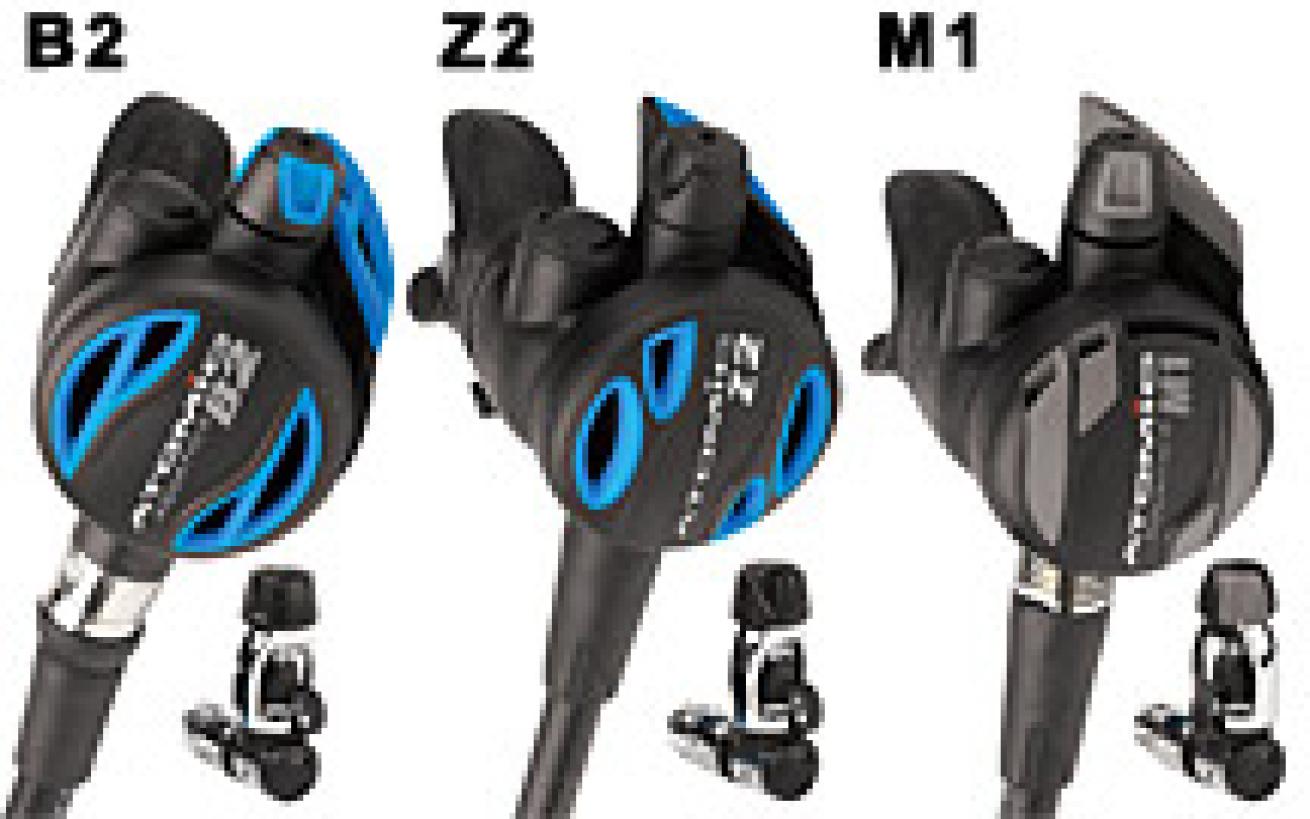
SCUBA DIVING Testers' Choice
>>SIMULATOR SCORES: 25 out of a possible 25.
>>ERGO SCORES: 58 out of a possible 70.
This year Atomic Aquatics submitted three regs for review: one new model and two upgrades. The Z2 is the newbie; it was released late last year. The B2 and M1 have been around for awhile, but Atomic has redesigned their second-stage cases and added new Automatic Flow Control (AFC) flow vanes to improve overall breathing performance.
All three of these models share the same basic first stage, a compact, balanced flow-through piston design with five low-pressure ports on a turret for easy hose routing. The second stages are pretty much the same too. They all offer AFC, which automatically adjusts airflow to maintain a stable breathing effort regardless of depth, and they feature Atomic's Seat Saving Orifice, which helps prolong second-stage seat life.
What sets these regs apart is primarily metals, plating and user-specific features. For example, the B2 couples a first stage made of polished 316 stainless steel and brass, to an all-titanium second-stage valve body for a lightweight reg with superior corrosion resistance. The second-stage hose also comes standard with Atomic's excellent Comfort Swivel (available as an option on the M1 and Z2). The Z2 we tested came with the same low-pressure port turret as the B2, but it actually comes standard with a fixed seven-port first stage that is more than $100 cheaper than the test rig. (The Z2 price listed in the features chart includes the turret option.) Its brass second-stage valve body is plated with palladium/zirconium for corrosion resistance, and the lever, orifice and second-stage spring are titanium.
The M1 is designed with technical divers in mind. Its first stage is made of brass and Monel, a high-grade alloy known for its strength, corrosion resistance and oxygen compatibility. The first stage comes standard with an environmental kit for cold-water diving (optional on other Atomic regs). Its second-stage valve body is made with palladium/zirconium plated brass with titanium components, and it's fitted with a thermal heat sink. The reg comes from the factory nitrox-ready to 50 percent, and oxygen mixes up to 80 percent can be used when special guidelines are followed. The reg has a slightly wider exhaust tee than other Atomic regs and its purge cover has flow slots cut into the sides to reduce free-flows when swimming into currents.
True to Atomic's claims, the redesigned B2 and M1 did deliver improved work of breathing on the simulator, although this improvement simply puts a shine on what was already stellar breathing performance. The Z2 effortlessly kept pace with its higher-priced brethren. When the regs were taken out for some real-world diving they proved to be sweet breathers in all positions. Test divers considered the B2, Z2 and M1 to be the driest breathing regs in this year's go-round. The regs come with a two-year/300-dive service interval, and the limited lifetime warranty is not contingent upon annual servicing.
APEKS: XTX200, XTX100 and XTX50
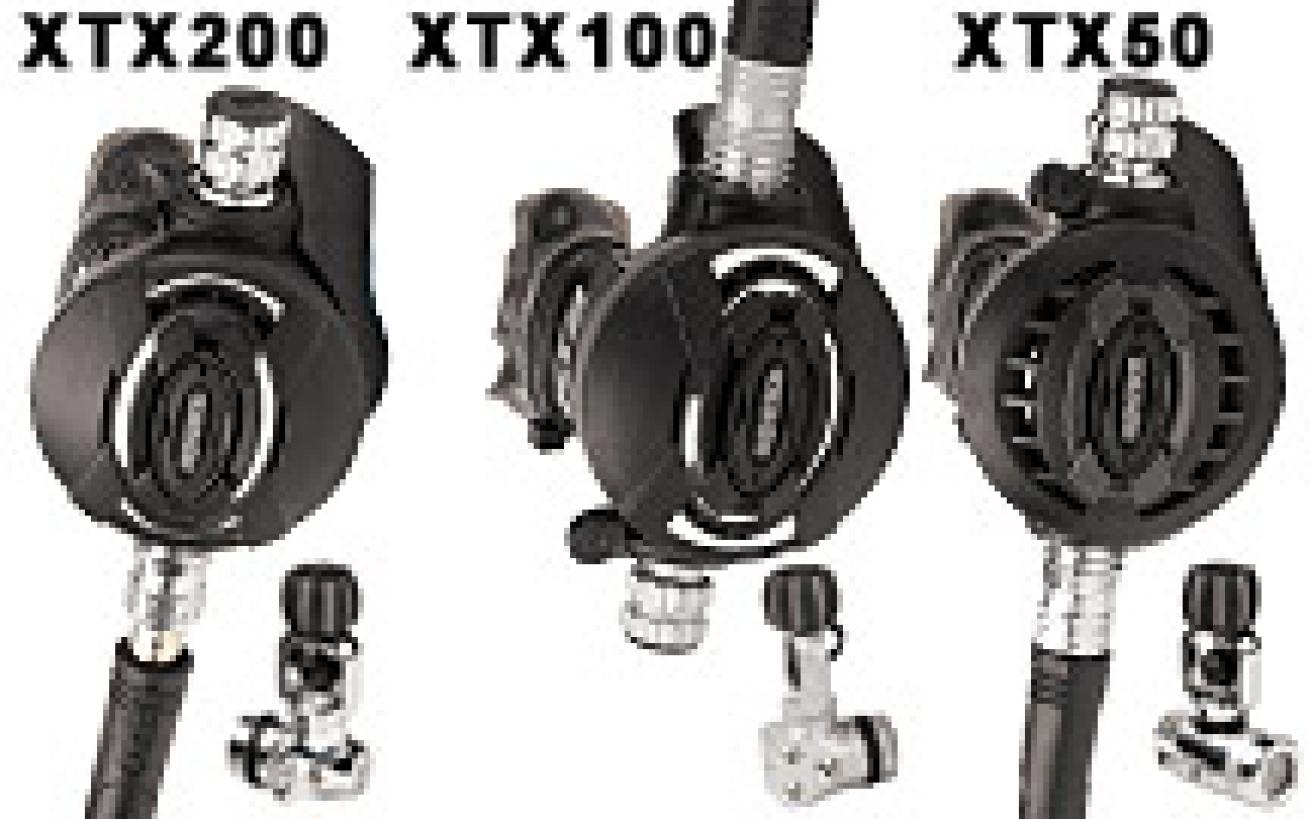
SCUBA DIVING Testers' Choice
>>SIMULATOR SCORES: 25 out of a possible 25.
>>ERGO SCORES: 55 out of a possible 70.
First Apeks gave us its TX Series of regs. Then came the ATX Series with smaller second stages. Now Apeks offers its XTX Series, so-named for their ability to convert the second stages to either left-hand or right-hand hose configuration (this switch must be performed by an authorized Apeks technician). The XTX200, XTX100 and XTX50 make up the top level of the XTX Series. Their pneumatically balanced second stages are virtually identical (the XTX50 doesn't have a chrome accent ring, but that's about it). They use the same efficient ratcheting Reversible Venturi System (RVS) dive/pre-dive switch, as well as a breathing-resistance knob that's notched so it's easy to use when wearing gloves. The regs also come with a choice of two easy-to-switch exhaust tees. We used the wider tee for all our tests, which kept bubble interference to a minimum. The narrower tee is lighter and more compact, but not quite as efficient in bubble dispersion.
While these regs sport different first stages, all are over-balanced diaphragm designs complete with dry seal environmental kits. This over-balancing feature allows the intermediate pressure in the second-stage hose to increase at a rate faster than ambient pressure, resulting in more responsive inhalation. The XTX200, flagship of the XTX Series, uses an elegant-looking first stage similar to the one found on the limited edition Black Pearl a couple years ago, but this version has a polished chrome finish. The satin-finished XTX100 first stage orients its external diaphragm downward, and the whole rig has a bullet-proof look. The XTX50 first stage incorporates four low-pressure ports on a rotating turret for optimal hose routing.\
When strapped to the breathing simulator, these three regs aced every RMV/depth category without breaking a sweat. They then repeated this performance in the ocean, where test divers rated them above-average breathers in all positions and very user-friendly when purging and operating the second-stage adjustments. All three regs come with a free parts replacement program.
AQUA LUNG: LEGEND SUPREME ACD, LEGEND LX ACD and LEGEND LX SUPREME ACD

SCUBA DIVING Testers' Choice
>>SIMULATOR SCORES: 25 out of a possible 25.
>>ERGO SCORES: 55 out of a possible 70.
Aqua Lung's top-end line of Legend regulators comes with a new feature designed to extend the life of the first stage. Called the Auto Closure Device (ACD), this seal closes off the first-stage inlet as soon as the reg is disconnected from the cylinder valve. This keeps water from entering the first stage during tank changes and post-dive rinses.
The Legend series uses an over-balanced diaphragm first stage with a dry seal environmental kit. The over-balance feature allows the intermediate pressure in the hose to increase at a rate faster than ambient pressure, resulting in more responsive inhalation. The black polyurethane coating gives the first stage a stylish Euro look while protecting the metal surfaces. Two high-pressure ports and four low-pressure ports are angled for optimum hose routing. Polished chrome port plugs that are flanged and dimpled further enhance the look.
The second stages on these three models, as well as on the standard Legend (see Under $500 regs, p. 57) are pneumatically balanced and come with easy-to-use Vane Adjustment Switches (VAS). The LX versions add a breathing-resistance knob so you can dial in or out on your inhalation effort at depth. The Legend LX comes with a gold accent ring on its second stage to differentiate it from the Legend Supreme and Supreme LX, which are Aqua Lung's cold-water models (recommended for water temperatures below 50 degrees). They come with a polished chrome yoke end cap on the first stage and a chrome retaining ring and laser-etched snowflake on the second stage. All Legends offer a choice of a Comfo-Bite or a standard mouthpiece, along with a reusable mouthpiece clamp for switching back and forth. The Legend Supreme and Supreme LX also include a rubber shield that fits over the mouthpiece to keep lips warm.
The snazzy design of these regs might suggest they're all style and no substance. But don't be fooled by good looks. These regs are some powerful breathers. On the breathing simulator, each model delivered surprisingly low work of breathing, regardless of how deep we took them or how high we cranked up the breathing rate. In the water, divers found these regs to be sweet breathers, dry, with powerful purges and simple user adjustments. The cold-water lip shield on the Supreme and Supreme LX took a bit of getting used to, but everybody agreed it helped keep lips warm. All three regs are available with a free parts replacement program.
Regulators Under $500
SCUBAPRO: MK17/S555
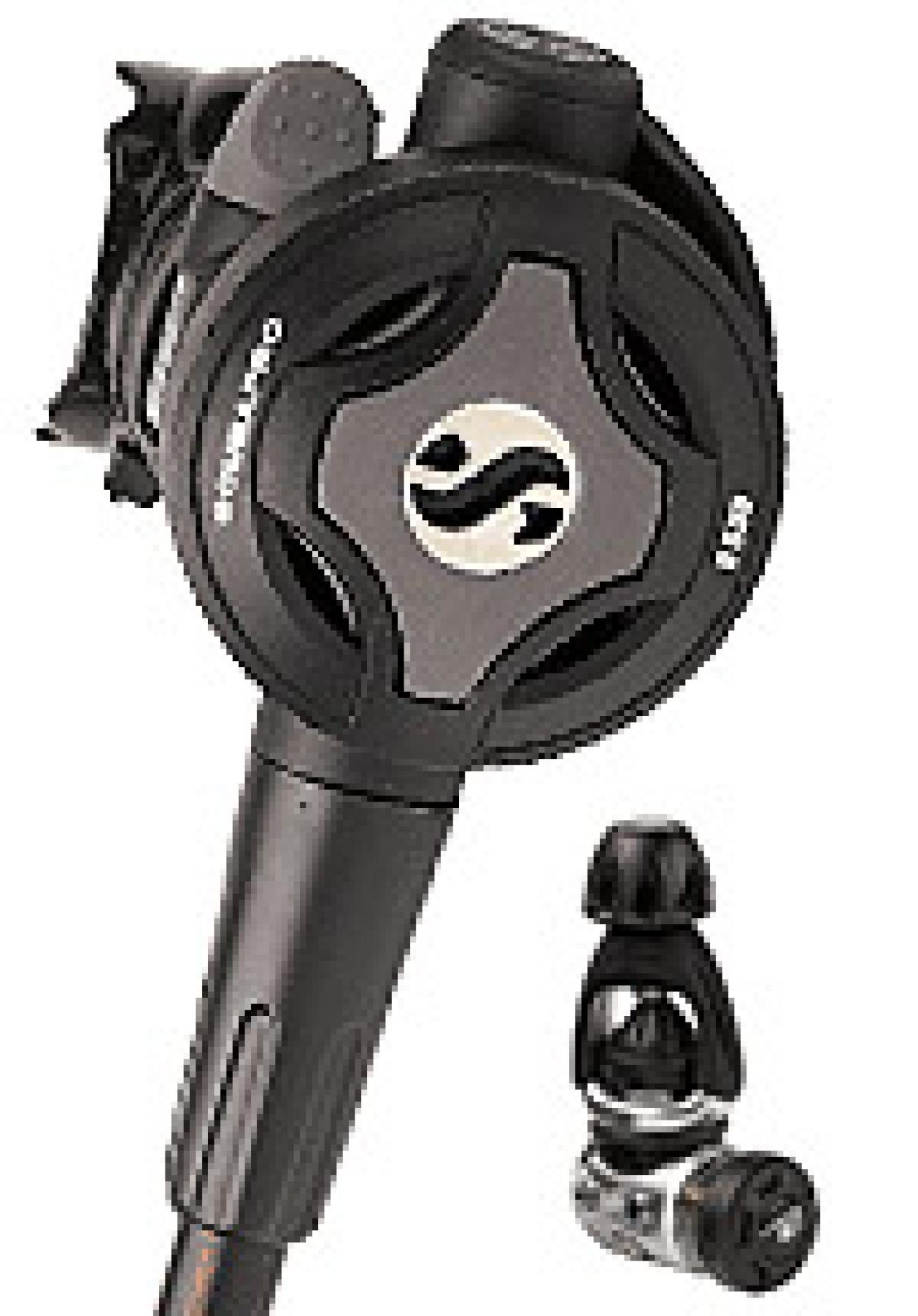
SCUBA DIVING Testers' Choice
>>SIMULATOR SCORES: 25 out of a possible 25.
>>ERGO SCORES: 54 out of a possible 70.
The new MK17 balanced diaphragm first stage is known around Scubapro as "The Icebreaker" because it has been designed for harsh environments and cold water use. Its Thermal Insulating System (TIS) and Anti Freeze (AF) System both protect internal parts with ice-repellent coatings and accelerate heat transfer, and a dry ambient chamber system prevents water intrusion for trouble-free operation in the coldest of water conditions.
The pneumatically balanced S555 second stage is also new. Its housing is made of metal and techno-polymer with carbon fiber to insulate and protect the valve-lever assembly. While the second stage has no breathing resistance knob, the Venturi Initiated Vacuum Assist (VIVA) is efficient in controlling surface free-flows, although the switch is small and can be hard to grasp when wearing gloves. But the purge is large and forceful, and the reg is a dry, easy breather in all positions. It comes with an orthodontically designed mouthpiece, making it one of only three regs to earn a clear majority of positive votes when rated for comfort. On the breathing simulator, the MK17/S555 was able to keep up with the best of them, earning the highest possible scores in all RMV/depth categories.
APEKS: TUNGSTEN ATX
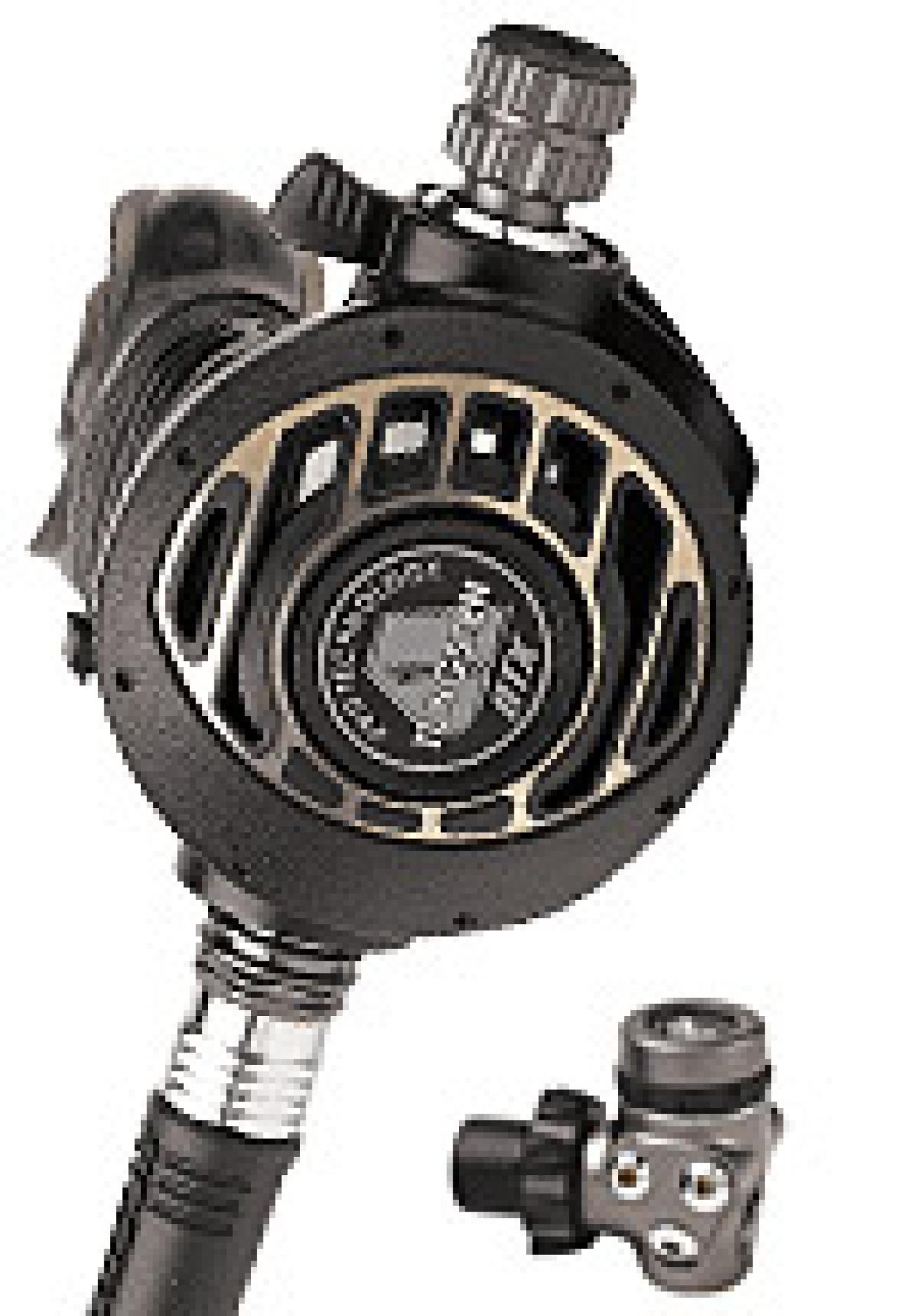
SCUBA DIVING Testers' Choice
>>SIMULATOR SCORES: 25 out of a possible 25.
>>ERGO SCORES: 53 out of a possible 70.
The Apeks Tungsten ATX gets its name from its rugged tungsten-steel color. It's similar to the ATX200, but has a durable PVD (physical vapor deposition) coating to protect the metal of the over-balanced first stage. This over-balanced feature actually increases inter-stage pressure at a rate faster than on traditional balanced models to help compensate for denser air. The first stage also has a dry environmental sealing system that eliminates the need for silicone, oil or grease.
The second stage is pneumatically balanced with a specially designed cover plate that surrounds an efficient center purge button. Its Integrated Venturi System (IVS) isn't ratcheted like on the XTX Series' RVS switches mentioned above, but it's just as effective. The reg also comes with a breathing resistance knob that's slotted to make it easy to grip when wearing gloves.
The Tungsten ATX was able to keep pace with its XTX Series cousins on the breathing simulator and in almost all real-world ergonomic tests. However, the reg uses a narrower exhaust tee. This makes for a compact second stage but allows for a bit more bubble interference. The Tungsten ATX comes with a free parts replacement program.
MARES: V42 PROTON METAL and V32 PROTON ICE EXTREME
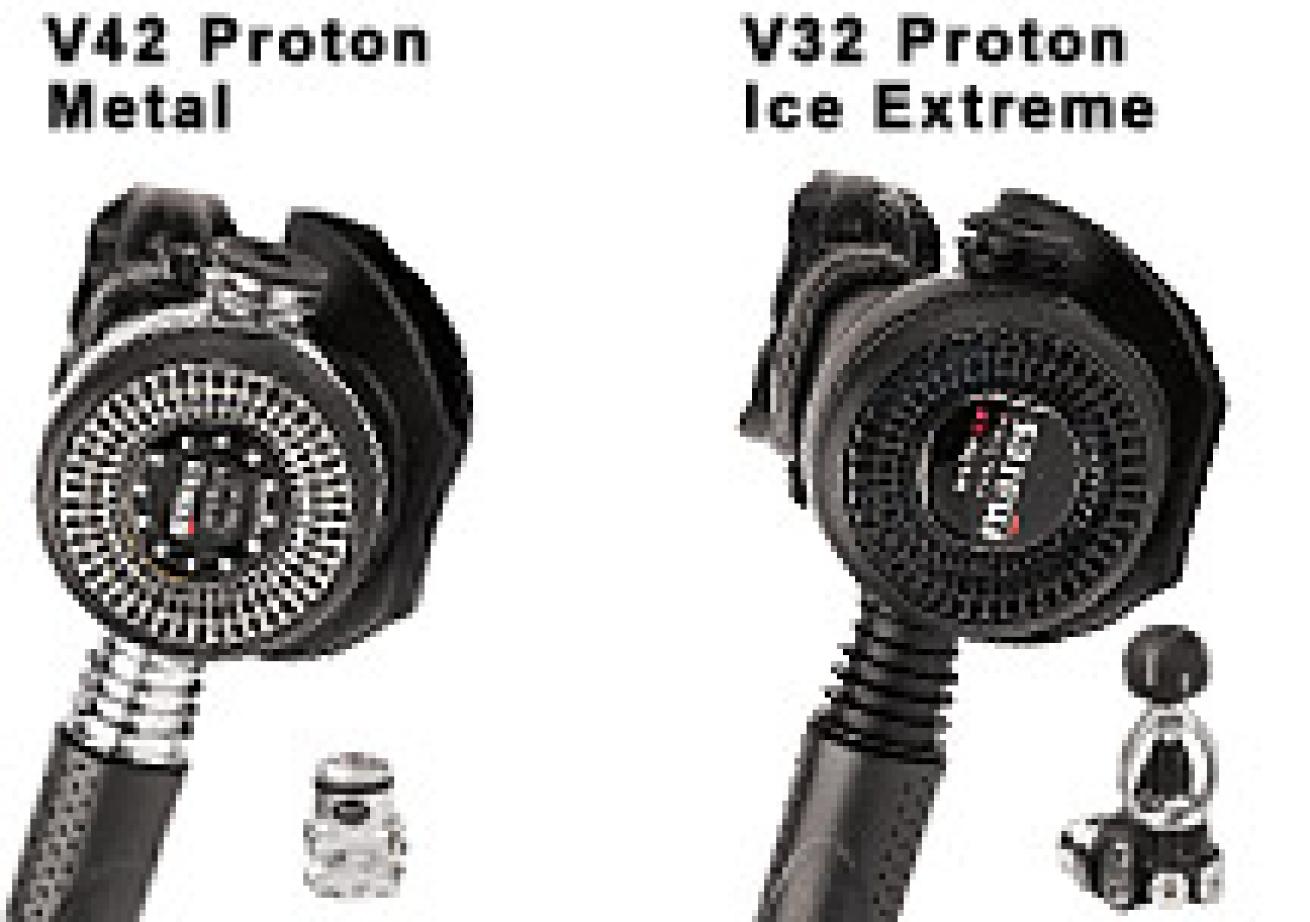
>>SIMULATOR SCORES: 23 out of a possible 25.
>>ERGO SCORES: 50 out of a possible 70.
Mares calls the V42 the smallest balanced diaphragm first stage on the market, and we believe it. The tiny V42 has a forged brass, nickel and chrome-plated body. The high-pressure valve features the Spherical Core Seal (SCS) to increase system durability. The low- and high-pressure ports are angled so hoses can be comfortably routed. The Dynamic Flow Control (DFC) on the primary low-pressure port minimizes the intermediate pressure drop which occurs during inhalation.
While the V42 can be fitted with a cold-water kit for harsh conditions, the V32 first stage comes standard with a cold-water kit that isolates all its internal components from contact with the water. Like the V42, it also has DFC and angled pressure ports for hose routing.
Both regs use compact, all-metal second stages made of nickel and chrome-plated brass. The Proton Ice Extreme is also coated with nonstick fluoropolymer resin to prevent ice crystals from sticking to the metal. This helps make it such a good cold-water performer that it survived testing by the U.S. Navy in saltwater chilled to 29 degrees Fahrenheit. A new version of Mares' Vortex Assisted Design (VAD) incorporates a bypass tube into the body of both second stages. As the air from the hose passes through the second-stage valve, it is routed directly to the mouthpiece via the tube. This contributes to a lower breathing effort at depth. The oversized purge button on both second stages is extremely easy to use, even while wearing gloves, and the mesh grids minimize free-flows in currents.
On the breathing machine, both regs delivered very good to excellent scores. In real-world diving conditions, test divers loved the lightweight, compact size of the V32 Proton Ice Extreme and the V42 Proton Metal. The second stages eschew diver adjustments, keeping things simple. They also breathe easy in a normal swimming position, although our V32 Proton Ice Extreme had a tendency to whistle when subjected to deep inhalations at depth. Their narrow exhaust tees allowed a bit more bubble interference than some of the other regs tested, but not so much that it was considered a problem.
AQUA LUNG: LEGEND ACD
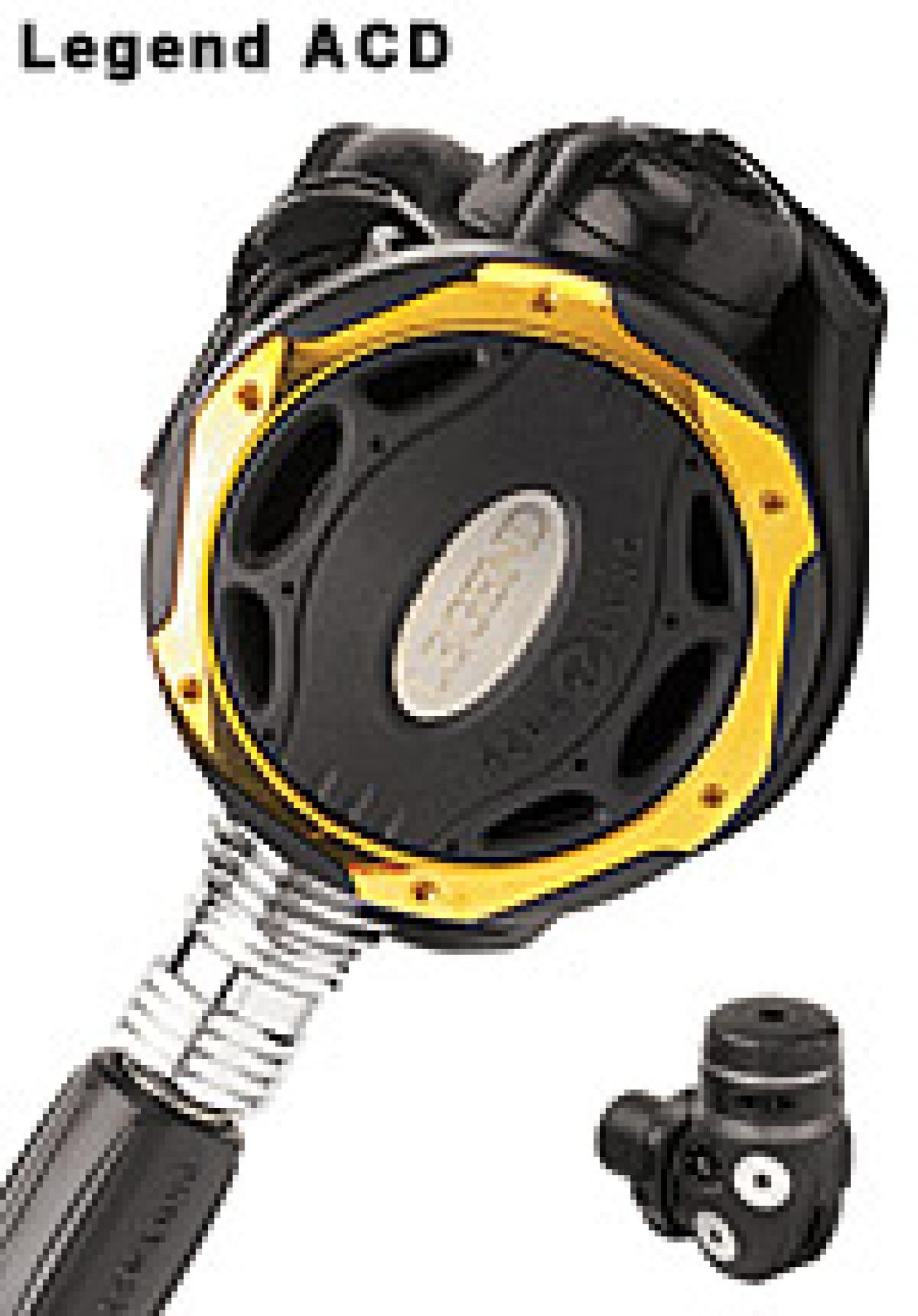
SCUBA DIVING Testers' Choice
>>SIMULATOR SCORES: 25 out of a possible 25.
>>ERGO SCORES: 55 out of a possible 70.
The Legend ACD is the standard model of the Legend line, and the only one to retail for less than $500. Yet when it comes to breathing performance, it can stand up to any of the more expensive Legends (see Over $500 regs). It also uses the Legend Series' black over-balanced diaphragm first stage with dry seal environmental kit, and features Aqua Lung's new Auto Closure Device (ACD) to keep water and contaminants out of its first stage. The second stage is fitted with a Vane Adjustment Switch (VAS) and dressed up with a gold accent ring. Basically, the only thing different between this Legend and the Legend LX is the lack of a breathing resistance knob, which allows you to dial in or out on your inhalation effort at depth. Performance-wise, they are virtually identical.
APEKS: XTX40 and XTX20
SCUBA DIVING Testers' Choice
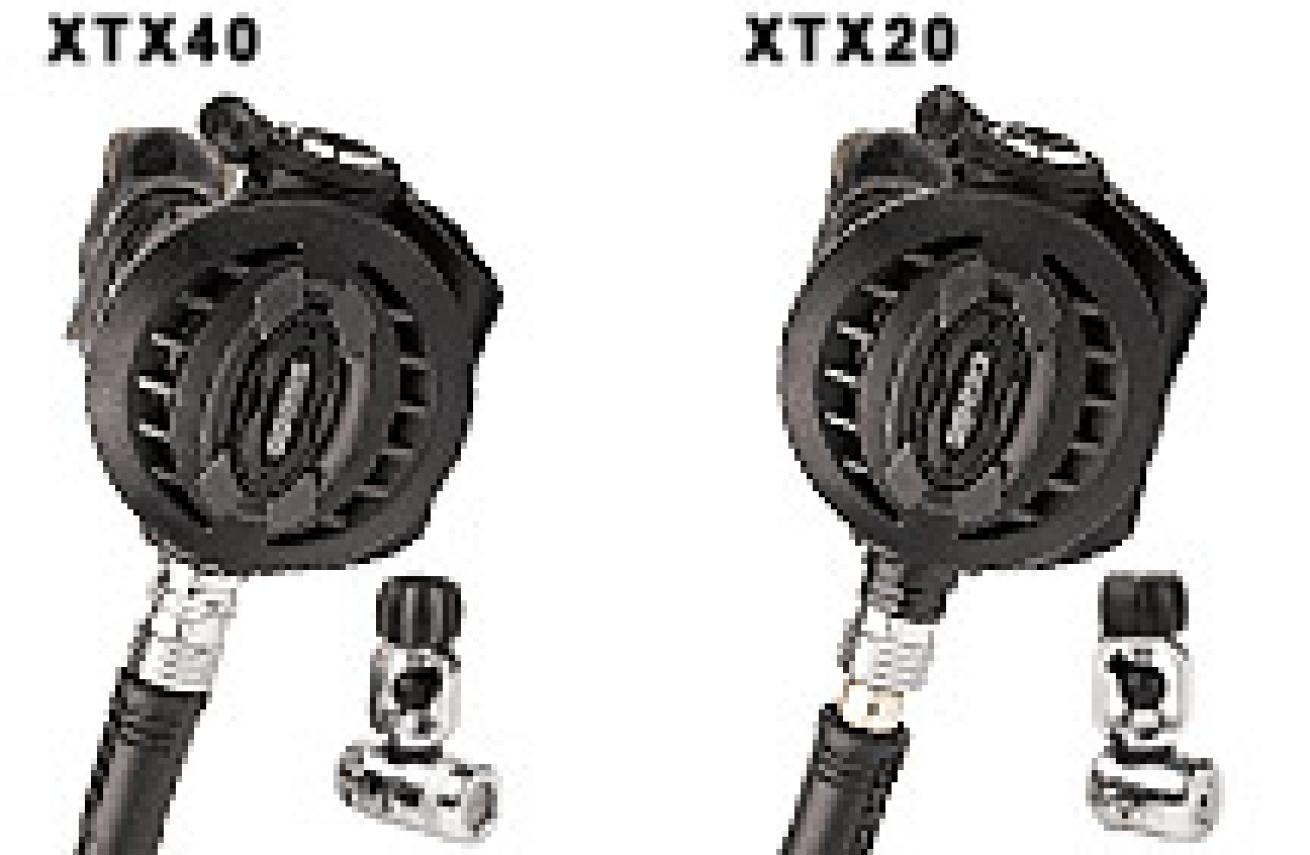
>>SIMULATOR SCORES: 25 out of a possible 25.
>>ERGO SCORES: 53 out of a possible 70.
The XTX40 and XTX20 are the lower-priced models in Apeks' new XTX Series. Their second-stage valves are also reversible, allowing the hose to be configured on the right or left side, and they offer the ability to switch between two styles of exhaust tees. Both regs use a pneumatically balanced second stage with a nonratcheting Reversible Venturi System (RVS) switch, but no breathing-resistance knob. They are also fitted with Comfo-Bite mouthpieces. The XTX40 uses the same over-balanced diaphragm first stage with dry seal environmental kit and low-pressure port turret as the XTX50. The XTX20, the lowest-priced model in the XTX line, uses a very compact, balanced diaphragm first stage and is referred to as the XTX Series' warm-water model (designed for water temperatures above 50 degrees Fahrenheit).
Performance-wise, these two regs are nearly identical to the higher-end XTXs, both on the breathing simulator and in real-world diving. In fact, the only category where they earned a slightly different score was in bubble interference, and that's because they were fitted with the narrower of the two available exhaust tees. (Both of these regs come standard with the narrow exhaust tee, though the wider tee is available as an option.) Otherwise, they were identical in performance to the top-end XTX regs. They also come with a free parts-replacement program.
ZEAGLE: REZORT (SCUBA DIVING Best Buy) and RAZOR

>>SIMULATOR SCORES: 22 out of a possible 25.
>>ERGO SCORES: 53 out of a possible 70.
These two new inexpensive regs deliver a lot of breathing performance for not a lot of money. They both use unbalanced flow-by piston first stages and rock-solid pneumatically balanced second stages with efficient dive/pre-dive switches. But while the ReZort's first stage is a traditional yoke style, the RaZor first stage assembly screws directly into a standard 3,000 psi cylinder. It includes a safety relief valve and an on/off knob to create a very simple, low-profile set-up that's perfect for stage bottles or for redundant air supply systems. It comes with a filling adapter so you can refill the tank using a standard whip.
Both regs deliver excellent performance at depths and breathing rates simulating typical recreational diving, and very good performance at more aggressive breathing rates and greater depths. In the water, both systems breathe well in the swimming position, but not as easily upside down, where they also tend to get some moisture. Wide exhaust tees minimize bubble interference. The dive/pre-dive switch is easy to use and the purge button, while a bit stiff, can really move some air. They are two of only three regs that received a clear majority of positive votes from test divers for their mouthpieces. While the RaZor is more of a special-use rig, the standard yoke ReZort, with its above-average performance and rock-bottom price, definitely gets our vote for a Best Buy.
More Testers' Choices
Still looking for the perfect reg? Here are the top performers and their test scores from last year's reg review. They're still in distribution, and definitely worth a look.
Over $500 Atomic: T2
>>Simulator Score: 25 out of a possible 25.
>>Ergo Score: 68 out of a possible 70.
The Ferrari of regulators with a price to match. Both the first and second stages are made from solid billet titanium components. The reg manhandled the breathing machine and earned the highest ergonomic scores of any regulator we've tested in the past five years. Price: $1,395.
Under $500 Oceanic Delta: 4/FDX-10
>>Simulator Score: 23 out of a possible 25.
>>Ergo Score: 58 out of a possible 70.
This reg comes loaded with goodies, including Dry Valve Technology (DVT) to keep water out of the first stage and Oceanic's patented Dynamic Adjustment on the second stage. This balancing system maintains a constant opening effort throughout the dive. Dial in your sweet spot, then leave it alone. The reg will automatically adjust to changes in depth. Price: $499.95.
Under $500 Mares: Abyss 05
>>Simulator Score: 22 out of a possible 25.
>>Ergo Score: 57 out of a possible 70.
Thanks to an all-metal second stage and a beefy MR22 balanced diaphragm first stage, you get a bulletproof reg that breathes effortlessly without user adjustments. It also combats dry mouth. Test divers praised it for quiet and dry breathing in all positions. Price: $499.
Under $500 XS: Scuba SeaAir Tri-Metal
>>Simulator score: 22 out of a possible 25.
>>Ergo score: 56 out of a possible 70.
Who says you have to spend a fortune to get raw power? This budget reg can hang with any top-dollar model when it comes to raw breathing performance in recreational conditions and when pushed to extremes. Price: $375.
Under $500 TUSA: RS-460 X-Pert
>>Simulator score: 22 out of a possible 25.
>>Ergo score: 54 out of a possible 70.
This simple and efficient breather combines a compact balanced diaphragm first stage with a lightweight second stage. Test divers found it a very easy breather in all positions. Price: $320.
Regulator Features to Consider
>> Piston or diaphragm first stage. To admit air from the tank into the regulator, first stages use a piston sliding in a smooth cylinder or a diaphragm (like a loose drumhead) that flexes. Each has advantages and disadvantages, but both can offer excellent breathing performance.
>> Balanced or unbalanced first stage. Balancing is an attempt to keep air delivery stable when tank pressures are low or demand on the regulator is high. However, many unbalanced first stages offer breathing performance very similar to balanced ones.
>> Number of ports. More ports means better hose routing options.
>> Balanced or unbalanced second stages. Balanced second stages can make the air flow more consistent, but most modern unbalanced second stages do just as well in the ergo and simulator tests.
>> Dive/Pre-dive switch. A second-stage adjustment useful to prevent free-flows on the surface.
>> Breathing resistance knob. Designed to be used under water, it can be used to tune out positive pressure breathing and free-flows caused by current.
>> Nitrox capability. Not all regs come factory-ready for oxygen enriched breathing gases.
>> Environmental sealing. Environmentally sealed first stages keep water out of the workings to prevent icing in cold (below 50F) or contamination in dirty water.
How (And Why) We Test Regulators
Scuba Lab is the only consumer products testing organization that works for the sole benefit of recreational divers. The goal of our exclusive Scuba Lab Reviews (found only in Scuba Diving magazine and archived on www.scubadiving.com) is to help you be an informed consumer of dive gear.
To fulfill this mission when testing regulators, we use an industry-standard ANSTI wet breathing machine, which is capable of measuring minute differences in the inhalation and exhalation resistance at variety of depths and breathing rates. Following internationally accepted test standards, a regulator's work of breathing (WOB) is measured in joules per liter for each complete inhale/exhale cycle, during which the highest inhale or exhalation pressure experienced by the "diver" should never exceed 25 millibars or a total WOB of 3 j/l.
If a reg exceeds either parameter, it "fails" our test, but that doesn't mean that it stops delivering air-only that the breathing resistance at some point in the cycle is higher than what is common for most modern regulators. All simulator tests are performed at a supply pressure of 725-760 psi. If a regulator can perform well at this supply pressure, it will perform as well or better at higher supply pressures.
Breathing Rates and Depths
Regulators are tested at four different RMV/depth combinations (RMV stands for Respiratory Minute Volumes-basically the amount of gas that is ventilated through the lungs in one minute). Here are the tests and what they represent:
>Column A: 37.5 RMV @ 132 fsw. A somewhat aggressive breathing rate at the maximum recreational diving depth. A physically fit recreational diver might breathe at this rate while swimming a long distance. (A relaxed diver on a drift dive will probably be breathing at 22 RMV or less.) A diver could theoretically maintain 37.5 RMV for five minutes or longer without becoming significantly winded.
>Column B: 75 RMV @ 132 fsw. An extremely aggressive breathing rate at the maximum recreational diving depth. A diver in excellent condition can breathe at 75 RMV for about one minute. This test represents how a reg might perform with a single diver breathing at an extremely heavy work rate. It also serves as a loose simulation of the stress a reg would be under if two divers were breathing off the same first stage in an air-sharing situation. Only the U.S. Navy and Scuba Lab use this breathing rate to help identify the outer limits of a reg's performance.
>Column C: 62.5 RMV @ 165 fsw. All regs sold in the European Common Market must pass a test standard known as EN250, which uses this RMV/depth as its benchmark. For this reason, it's also the depth and breathing rate most commonly used by manufacturers to test regulators. This is a very aggressive breathing rate. A recreational diver in excellent condition chasing a bat ray through open water would probably be able to maintain 62.5 RMV for only a few minutes.
>Column D: 62.5 RMV @ 198 fsw. This is the U.S. Navy's Class A test depth and breathing rate, although they use a higher supply pressure than our standard 725-760 psi. We conduct this extreme test (no diver should ever be breathing this aggressively at this great a depth with this little air in left in his tank) to explore the outer limits of a reg's performance.
Scoring the Results
A machine as accurate as the ANSTI simulator can accurately differentiate j/l measurements to tenths and even hundredths of a point. Human divers, however, can't detect differences much smaller than about .5 j/l. So for the sake of simplicity, we translate j/l measurements into scores on a 2 to 5 scale as follows:
5 = Excellent: A total WOB of 1.05 j/l or less.
4 = Very Good: A total WOB of 1.06 to 1.55 j/l.
3 = Good: A total WOB from 1.56 to 2.25 j/l.
2 = Fair: A total WOB of 2.26 to 3.0 j/l.
If a reg is unable to achieve the RMV/Depth category, its maximum depth within test parameters is recorded instead of a score.
Ergonomic Tests: The Human Factor
Breathing machines tell only half the story, however. To gauge the ergonomic traits of regulators, we use a minimum of six test divers. These divers represent a cross section of the sport and differ in age, dive experience, gender and diving interests. Each diver rates each reg for user friendliness in seven areas, divided into three categories:
Most Important
>Ease of breathing: How well a regulator delivers air in the standard swimming position.
>Different positions: How the regulator breathes when the diver is in a heads-up or face-down position.
>Dryness: Does the regulator breathe wet or dry in both a normal swimming position and odd swimming positions.
Moderately Important
>Bubble interference: Considered while looking down, straight ahead, up at a 45-degree angle and straight up.
>Ease of clearing: Divided into two parts: 1) How easy is it to find and use the purge button, and the force of the purge. 2) How much effort is required to clear the regulator using the blowing method.
Convenience Items
>Comfort: Test divers rate the comfort of the mouthpiece, the feel of the second stage in the mouth, hose lengths and stiffness.
>Adjustments: Are adjustments easy to find, grip and turn? Do they do their job in a reasonable manner? Performance is recorded using both numeric scores on a 1 to 5 scale (5=Excellent, 4=Very Good, 3=Good, 2=Fair, 1=Poor) and written comments.
How We Pick Testers' Choice
In this review, Scuba Lab ratings-including Testers' Choice-are awarded within price ranges based on total scores for simulator and ergonomic tests.
Ergonomic scores are adjusted as follows: Actual scores x 3 for "Most Important" categories, actual scores x 2 for "Moderately Important" categories, and actual scores x 1 for "Convenience Elements" excluding user adjustments, which aren't found on every reg.
Simulator scores are adjusted x 2 only for Column A, the RMV/Depth test that best represents typical recreational diving (37.5 RMV @ 132 fsw).
User Adjustments Explained
Not all manufacturers offer user adjustments on their regs, because not all divers want to hassle with knobs and switches while they're enjoying the sights under water. But for those divers who like to take a hands-on approach to air delivery there are basically two types of user adjustments:
>> Breathing-resistance knobs
These controls enable you to adjust your breathing effort based on diving conditions like depth or current. As you dial in on the knob, pressure is put on the second-stage spring, which pushes on the seat, which increases breathing effort. This can be a good thing when passing through a surf line or swimming into a strong current. Dial out on the knob and spring and seat pressure are eased, making it easier to generate airflow. This can reduce breathing effort when descending to greater depths.
>> Dive/Pre-Dive Switches
Often known by such proprietary names as Vane Adjustment Switch (Aqua Lung), Integrated Venturi System and Reversible Venturi System (Apeks) and Venturi Initiated Vacuum Assist (Scubapro), these controls change the angle of a vane inside the second stage casing. When turned to the "closed" or "minus" position, the vane adjusts to deflect airflow inside the casing, reducing a reg's sensitivity to free-flow while on the surface. Once you get under water, turn the switch to the "open" or "plus" position, the vane rotates and you have maximum airflow with which to enjoy your dive.
Regulator Warranties
Regulator manufacturers appear to be heading in the same direction-which is a good direction for divers-when it comes to warranties. In 2003, of the 24 regs submitted for testing, only 13 offered limited lifetime warranties. In 2004 nine regs out of a total of 15 offered limited lifetime warranties, and in 2005 it was six out of 12. But this year, of the 18 regs submitted by manufacturers for review, every single one of them come with a limited lifetime warranty. Whether this is a result of market pressure, or the simple fact that these regs are so much better than your average breathers, the real winners are today's divers.
Mystery of the Mouthpieces
We don't know if it's because these regs performed so well that test divers had time to obsess on minor matters, or if the 58-degree water temperatures during our test dives caused them to be more sensitive than usual, or if a larger percentage of female divers this year skewed score averages. But this time around, when it came to comfort scores, we couldn't get a clear consensus-good or bad-on the majority of this year's mouthpieces.
In past years' tests, Atomic's dual silicone mouthpiece was rated an across-the-board favorite. But this year, while most male test divers found the dual silicone mouthpiece to their liking, most female test divers felt it was a bit too big. The same was true with Aqua Lung's Comfo-Bite mouthpiece, as well as the mouthpiece on both Mares' regs. In each case, there was no middle-of-the-road position; divers either really liked the mouthpiece, or they really didn't like it. (Scubapro and Zeagle mouthpieces were the only exceptions to this.)
Consequently, while the regs in question averaged a Good rating for comfort (see Ergonomic Performance chart, p. 91), this doesn't reflect the opinion that these mouthpieces were only average. Rather, it's the midpoint between extreme opinions. Bottom line: While the mouthpiece is arguably the most personal part of a regulator, it's also the easiest thing to change if you don't happen to like it.
MANY THANKS To Mike Ward of Dive Lab, Panama City Beach, Fla., for his work on the ANSTI breathing simulator; to George Perez of Sea Divers, Enterprise, Ala., for his technical support during lab tests; and to Express Divers, Long Beach, Calif., for the in-water portion of the tests aboard Island Time.

